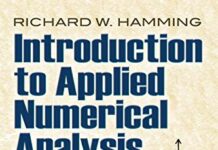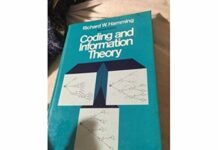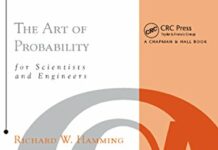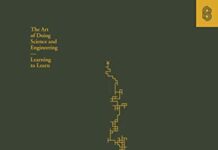
Ebook Info
- Published: 2012
- Number of pages: 882 pages
- Format: PDF
- File Size: 20.33 MB
- Authors: Richard W. Hamming
Description
Understanding calculus is vital to the creative applications of mathematics in numerous areas. This text focuses on the most widely used applications of mathematical methods, including those related to other important fields such as probability and statistics. The four-part treatment begins with algebra and analytic geometry and proceeds to an exploration of the calculus of algebraic functions and transcendental functions and applications. In addition to three helpful appendixes, the text features answers to some of the exercises. Appropriate for advanced undergraduates and graduate students, it is also a practical reference for professionals. 1985 edition. 310 figures. 18 tables.
User’s Reviews
Reviews from Amazon users which were colected at the time this book was published on the website:
⭐Richard Hamming was one of the greatest mathematicians of the XX century. He was a deep thinker and a gifted writer, and shone for his clarity in exposition as very few have done. In this regard he stands for me in the same category of greatness as Vladimir Arnol’d. This book is Hamming’s book on calculus. It is not yet another calculus book. It is Hamming’s calculus. That means that there is a lot of mathematical depth, clearly explained, together with witty comments and valuable philosophical and pedagogical discussions. The treatment of probability, Fourier and induction are excellent. I particularly enjoy the constant encouragement to “learn to learn” and to “learn not the results but how to produce new results from principles”. This book is a true jewel, full of substance and insight. Its price is negligible in comparison with its value.
⭐The book itself deserves 5 stars – one of the best written and approachable mathematics books ever written. Unfortunately, all the mathematical expression are pictures, not text — expression text is smaller than the smallest Kindle font, and they don’t scale to different font sizes. They are so small that they are barely readable on an actual Kindle, such as a Paperwhite, and essentially impossible to read on a higher-resolution devices like Android tablets and phones. Maybe it should come with a magnifying glass. I haven’t tried it on an iProduct.
⭐There is awesome CLARITY and SIMPLICITY in what the author writes and I say this after just reading a few pages. I had bought many math books but the simplicity in this one is beautiful. If you want to revise induction/ differentiation/ integrals/ sequence and series…etc…this should be the first book and may be the only one you can buy
⭐I received this text on time per vendor. This is a golden text for a clear and concise understanding of applied calculus. Thank GOD for this contribution from one of the MASTERs (Prof. Richard W. Hamming) who should have earned a Noble Prize in Mathematics and Science.
⭐Many (most?) of the equations are rendered as tiny low resolution graphics making it impossible to read as one is used to reading a math text. This makes for a very frustrating experience. Hamming is worth reading, so looking for a used hard copy of the original.
⭐A great introduction into applied calculus.
⭐It is good to see this fine book reappear in print from the misty depths of publishing obscurity.”Methods” is an elementary calculus text, covering the basic ground all such texts cover: differentiation; integration; methods of integration; the elementary calculus of polynomials, transcendentals and Taylor series. The presentation is clear and engaging; the exercises are well chosen. The book is unconventional in one important way, however, and this is what renders the book worthy of special note: it emphasizes throughout to the reader the critical importance of probabilistic thinking.In the world of science and engineering, sound probabilistic thinking is critically important, but it is also conceptually difficult and can take years to master. The student is forced to unlearn the idea, firmly acquired in high school, that a number (like 3) is a definite thing. If you measure something to be three inches long, do you mean that it is exactly three inches? Or might it be 3.1 or 2.9? Can you quantify mathematically how accurate your “three” really is? If you cannot yet do so, then you will be able to when you have finished this book.Having read this book, one wonders why no one else had ever thought of presenting elementary calculus in this way before. All competent elementary calculus texts develop their readers’ foundation in basic calculus concepts by means of numerous examples and exercises. Hamming’s innovation is in drawing these necessary examples and exercises often from the inherently interesting and important field of probability and statistics. Other calculus texts tend to contrive examples and exercises of little interest in themselves—which is okay as far as teaching calculus is concerned, but which is also a waste of a fine opportunity to teach something else useful along the way. Hamming does not waste the opportunity. Reading “Methods”, you will learn the elements of calculus, and almost incidentally also establish a sound foundation in probability. With Hamming, you spend the time and effort to learn the calculus, then you get the probability and statistics more or less for free.”Methods” is especially strong in its treatment of series, and its introduction to mathematical induction is the best I have ever read.No book covers everything, nor is any book perfect. This book does suffer from a few confusing typos (however, the presentation is sound enough that the attentive reader can successfully identify and correct these). If you want a book which is heavy in analytic geometry (conic sections, Kepler’s laws, and the volumes of toroids, for example), this is not the book for you. Hamming’s own background is in signals—vectors and three-dimensional fields are not really Hamming’s thing—and this comes through in the book’s weak treatment of multivariable calculus: in this reviewer’s opinion, the book’s only real drawback. Calculus is much too big a topic for any single book fully to cover: you will get a clear introduction to calculus here, not an exposition of advanced calculus topics; and of course you will not learn here all there is to know about probability and statistics, either. Hamming died in 1998, so if you are an instructor who desires a living author who is able to respond to enquiries, this fine book may not be quite the right book for you. However, if you are a student who wants to learn the fundamentals of calculus and also wishes to learn to analyze and to quantify the imprecision which is everywhere inherent in the natural world around us, or if you are a calculus instructor who wants his students to learn probability concepts as early as possible, then this well written book is without parallel, worth significantly more (in this reviewer’s opinion) than competing books which come at twice or thrice the price.(Note: The reviewer’s own copy of the book is of the original 1985 edition. The reviewer has not seen the new Dover printing.)
⭐I am indebted to Hamming for having written this phenomenal text. I am currently a second semester junior, and while I have been taught all the material included within this book, I never felt that I acquired a true mastery. This book gives a very rigorous introduction to elementary material. Working through this book is a pleasure as there is no shortage of epiphanies to be had from a student who was taught math at only a very superficial level. This book serves as an excellent gateway book to more advanced upper level undergraduate math texts, just make sure to do the exercises. It is more about developing the ability to think in terms of mathematical methods rather than memorizing domain knowledge related to “Calculus, Probability, and Statistics”.
⭐The best maths book!
⭐All concepts are explained clearly. You will love it.
⭐Very happy with this book!
⭐Eine sehr empfehlenswerte Abwechslung zu den geangigen Vorlesungen.Hamming, who work at on by Manhatten Project, declarces with his book the unbelieveable fortune of the 20th american century !
Keywords
Free Download Methods of Mathematics Applied to Calculus, Probability, and Statistics (Dover Books on Mathematics) in PDF format
Methods of Mathematics Applied to Calculus, Probability, and Statistics (Dover Books on Mathematics) PDF Free Download
Download Methods of Mathematics Applied to Calculus, Probability, and Statistics (Dover Books on Mathematics) 2012 PDF Free
Methods of Mathematics Applied to Calculus, Probability, and Statistics (Dover Books on Mathematics) 2012 PDF Free Download
Download Methods of Mathematics Applied to Calculus, Probability, and Statistics (Dover Books on Mathematics) PDF
Free Download Ebook Methods of Mathematics Applied to Calculus, Probability, and Statistics (Dover Books on Mathematics)




